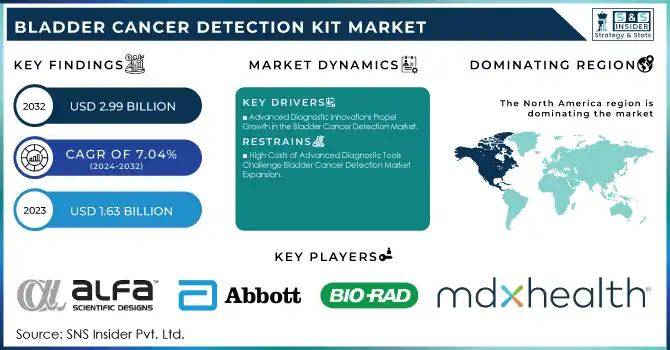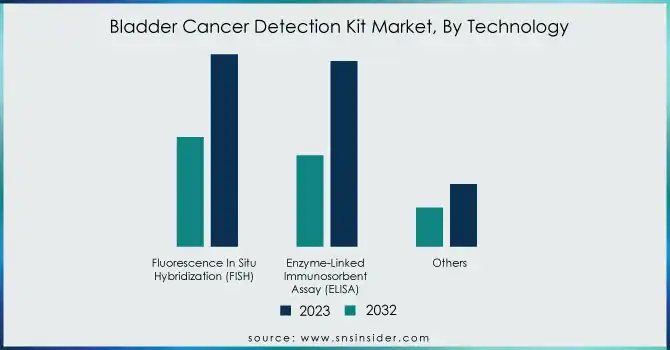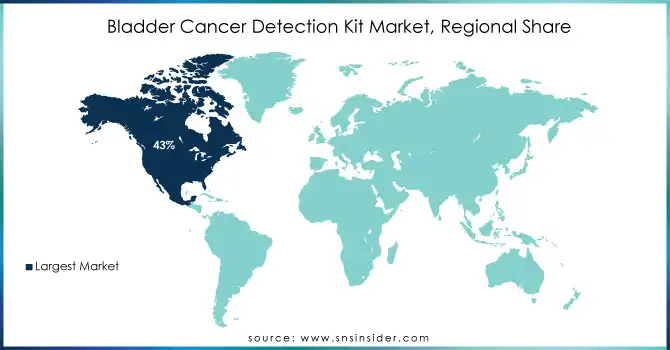Bladder Cancer Detection Kit Market Report Scope & Overview:

Get more information on Bladder Cancer Detection Kit Market - Request Sample Report
The Bladder Cancer Detection Kit Market was valued at USD 1.63 billion in 2023 and is expected to reach USD 2.99 billion by 2032, growing at a CAGR of 7.04% from 2024-2032.
The bladder cancer detection kit market is growing rapidly due to the rising prevalence of bladder cancer globally, which has driven a greater emphasis on early detection. In 2023 alone, 1,958,310 new cancer cases and 609,820 cancer deaths are projected to occur in the United States, underscoring the urgent need for effective diagnostic tools. Early detection is crucial as it significantly improves patient outcomes, prompting healthcare providers to adopt advanced diagnostic technologies. These technologies, including biomarker-based kits and liquid biopsies, have made cancer detection more accurate and less invasive, encouraging their widespread use. Furthermore, the growing aging population, coupled with lifestyle factors like smoking, has increased the at-risk population, thereby amplifying the demand for reliable diagnostic solutions.
This growing demand is further fueled by the healthcare industry's shift toward more patient-friendly, non-invasive diagnostic methods, which provide ease of use and convenience. Non-invasive tests, such as urine-based assays, are gaining traction as they eliminate the discomfort and risks associated with traditional diagnostic procedures like cystoscopy. Building on this trend, the integration of artificial intelligence (AI) into detection kits is enhancing diagnostic precision, enabling earlier and more reliable cancer identification. This technological evolution has also opened doors for broader adoption in emerging markets, where affordability and accessibility are critical considerations.
Looking forward, the market’s future is shaped by expanding healthcare infrastructure and increased awareness campaigns promoting early screening, particularly in developing regions. These initiatives are supported by rising investments in research and development, which aim to refine diagnostic accuracy and affordability. Moreover, the adoption of telemedicine and at-home diagnostic solutions is making bladder cancer screening more accessible, creating a seamless experience for patients. This alignment of technological innovation, healthcare accessibility, and rising awareness positions the bladder cancer detection kit market for sustained growth and transformative opportunities.
Bladder Cancer Detection Kit Market Dynamics
DRIVERS
-
Advanced Diagnostic Innovations Propel Growth in the Bladder Cancer Detection Market
Advancements in non-invasive diagnostic techniques, such as urine-based biomarker tests and molecular diagnostics, are transforming the way bladder cancer is detected. By eliminating the need for invasive procedures like cystoscopy, these innovations enhance patient comfort and encourage early testing. Building on this progress, the integration of artificial intelligence (AI) and machine learning further improves diagnostic accuracy by enabling precise identification of cancer markers. These AI-driven tools not only reduce the risk of errors but also expedite analysis, offering faster and more reliable results. This seamless combination of patient-friendly methods and cutting-edge technology is fostering greater adoption among healthcare providers. As a result, the demand for advanced bladder cancer detection kits continues to grow, making these technological breakthroughs a cornerstone of market expansion.
-
Growing Global Incidence of Bladder Cancer Fuels Demand for Advanced Detection Solutions
The rising global burden of bladder cancer, particularly among aging populations, is creating an urgent need for effective diagnostic tools. As the elderly are more susceptible to this condition, the demand for early detection methods has surged to improve outcomes and reduce mortality rates. Bladder cancer consistently ranks among the top 10 most common cancers worldwide, with developed regions reporting the highest incidence due to lifestyle factors and improved detection capabilities. This trend underscores the importance of early and accurate diagnostic solutions to identify cancer at its initial stages. The increasing awareness about cancer prevention and the benefits of early intervention are further driving the adoption of advanced detection kits. These solutions are now central to addressing the growing prevalence and ensuring timely, efficient patient care.
RESTRAINTS
-
High Costs of Advanced Diagnostic Tools Challenge Bladder Cancer Detection Market Expansion
The development of advanced bladder cancer detection kits, including those utilizing molecular diagnostics and AI-driven technologies, has significantly improved diagnostic accuracy and efficiency. However, these innovations come at a high cost, making them unaffordable for healthcare systems in low- and middle-income countries. The expensive production processes, coupled with the integration of cutting-edge technologies, contribute to their premium pricing. This limits accessibility for resource-constrained healthcare providers and patients, particularly in regions with limited healthcare budgets. As a result, many patients in these areas continue to rely on traditional, invasive, or less effective diagnostic methods. Without cost-effective alternatives or subsidized pricing models, the widespread adoption of these advanced kits remains a significant challenge, slowing the market's penetration into economically disadvantaged regions.
Bladder Cancer Detection Kit Market Segment Analysis
BY TECHNOLOGY
In 2023, the Fluorescence in Situ Hybridization (FISH) segment dominated the bladder cancer detection kit market with a 46% revenue share. This was due to its exceptional accuracy in detecting chromosomal abnormalities linked to bladder cancer, making it indispensable for early diagnosis and monitoring. Its proven reliability in identifying even low-grade tumors and its wide acceptance among oncologists and labs further solidified its leading position.
The Enzyme-Linked Immunosorbent Assay (ELISA) segment is projected to grow at the fastest CAGR of 8.26% from 2024 to 2032. This growth is driven by ELISA's affordability, ease of use, and scalability for large-scale screenings. Advancements in biomarker research have enhanced its precision, and its compatibility with non-invasive urine-based testing makes it a highly attractive solution for emerging diagnostic needs.

BY END USER
In 2023, the Hospitals & Clinics segment accounted for 57% of the bladder cancer detection kit market's revenue, driven by their pivotal role in cancer diagnosis and treatment. These facilities offer advanced diagnostic technologies, specialized expertise, and comprehensive care, making them the first choice for patients with suspected bladder cancer. Their ability to manage complex cases and integrate diagnosis with treatment further reinforces their dominant position in the market.
The Diagnostic Centers segment is anticipated to grow at the fastest CAGR of 8.54% from 2024 to 2032 due to the rising demand for affordable and specialized testing services. These centers provide quick, accurate, and non-invasive diagnostic options, appealing to patients seeking convenience. As healthcare trends shift toward decentralized care, diagnostic centers are gaining traction, supported by advancements in diagnostic technology and an emphasis on early detection.
BY TEST TYPE
In 2023, the Cystoscopy segment led the bladder cancer detection kit market with a 38% revenue share due to its status as the gold standard for bladder cancer diagnosis. Its unparalleled accuracy in detecting tumors and providing direct visualization of the bladder makes it indispensable for definitive diagnoses. Additionally, its widespread adoption among urologists and integration into standard diagnostic protocols have solidified its dominant position in the market.
The Urine Lab Test segment is expected to grow at the fastest CAGR of 8.37% from 2024 to 2032, driven by the increasing demand for non-invasive and cost-effective diagnostic methods. These tests, which analyze urine for cancer biomarkers, are gaining popularity due to their simplicity, accessibility, and patient comfort. As advancements in biomarker research enhance test accuracy, urine lab tests are becoming a preferred choice for early detection and follow-up monitoring, fueling their rapid market growth.
Bladder Cancer Detection Kit Market Regional Outlook
In 2023, North America accounted for 43% of the bladder cancer detection kit market's revenue, driven by advanced healthcare infrastructure and a high prevalence of bladder cancer in the region. The strong presence of leading diagnostic companies, coupled with substantial investments in cancer research, has fostered widespread adoption of innovative detection technologies. Additionally, robust awareness campaigns and favorable reimbursement policies have further solidified North America's leadership in the market.
The Asia Pacific region is projected to grow at the fastest CAGR of 9.77% from 2024 to 2032, fueled by increasing healthcare expenditure and rising cancer awareness. Rapid urbanization and lifestyle changes have led to a growing incidence of bladder cancer in countries like China and India, boosting demand for diagnostic solutions. Additionally, government initiatives to improve early detection and expand access to advanced healthcare technologies position Asia Pacific as a key growth driver in the global market.

Need any customization research on Bladder Cancer Detection Kit Market - Enquiry Now
LATEST NEWS-
-
In December 2023, Pangea Laboratory's Bladder CARE Assay received FDA Breakthrough Device Designation, streamlining its regulatory review and development for bladder cancer detection.
-
On September 9, 2024, A. Menarini Diagnostics and Nucleix announced a strategic partnership to exclusively market the non-invasive Bladder EpiCheck® test in Europe for bladder cancer detection and monitoring.
KEY PLAYERS
-
Alfa Scientific Designs (FOB Rapid Test, PSA Prostate Specific Antigen Test)
-
Diagnosis S.A. (Further product information not available)
-
Abingdon Health (Seralite Diagnostic Test, Lateral Flow Rapid Test Kit Platform)
-
Exact Sciences (Cologuard Test, Oncotype DX)
-
Abbott Laboratories (Alinity m System, UroVysion FISH Test)
-
NanoEnTek Inc. (FREND System, Hemoglobin A1c Diagnostic Test)
-
Xiamen Biotime Biotechnology (Urinalysis Rapid Test Strips, Infectious Disease Diagnostic Tests)
-
Ameritek, Inc. (Drug Screening Products, Urine-based Diagnostics)
-
Nanjing Liming Bio-products Co., Ltd. (Clinical Immunoassays, Pathogen Rapid Tests)
-
Hubei Jinjian Biology (POCT Kits, Rapid Immunoassay Tests)
-
Xiamen Boson Biotech Co., Ltd. (Rapid COVID-19 Antigen Test, Multiplex Urinary Tests)
-
Pangea Laboratory (Bladder CARE Assay, qPCR Urine Test)
-
AnchorDx (UriFind, Liquid Biopsy Test)
-
Vesica Health (AssureMDx, DNA Biomarker Test)
-
MDxHealth (Cytosponge, SelectMDx)
-
Nonacus (Bladder EpiCheck, Urine DNA Test)
-
Genomic Health (Oncotype DX Urothelial, Diagnostic Assays)
-
Bio-Rad Laboratories (Droplet Digital PCR, QX200 System)
-
NeoGenomics (Molecular Diagnostic Tests, FISH Testing Services)
-
Cepheid (GeneXpert Bladder Cancer Assay, Xpert Urine Test)
-
Alere (UroVysion, Rapid Urinary Tests)
-
Menarini Diagnostics (Bladder EpiCheck, FluoroType UTI Assays)
| Report Attributes | Details |
|---|---|
| Market Size in 2023 | USD 1.63 Billion |
| Market Size by 2032 | USD 2.99 Billion |
| CAGR | CAGR of 7.04% From 2024 to 2032 |
| Base Year | 2023 |
| Forecast Period | 2024-2032 |
| Historical Data | 2020-2022 |
| Report Scope & Coverage | Market Size, Segments Analysis, Competitive Landscape, Regional Analysis, DROC & SWOT Analysis, Forecast Outlook |
| Key Segments | • By Test Type (Cystoscopy, Urine Lab Test, Biopsy, Imaging Test) • By Technology (Fluorescence In Situ Hybridization (FISH), Enzyme-Linked Immunosorbent Assay (ELISA), Others) • By End User (Hospitals & Clinics, Diagnostic Centers, Others) |
| Regional Analysis/Coverage | North America (US, Canada, Mexico), Europe (Eastern Europe [Poland, Romania, Hungary, Turkey, Rest of Eastern Europe] Western Europe] Germany, France, UK, Italy, Spain, Netherlands, Switzerland, Austria, Rest of Western Europe]), Asia Pacific (China, India, Japan, South Korea, Vietnam, Singapore, Australia, Rest of Asia Pacific), Middle East & Africa (Middle East [UAE, Egypt, Saudi Arabia, Qatar, Rest of Middle East], Africa [Nigeria, South Africa, Rest of Africa], Latin America (Brazil, Argentina, Colombia, Rest of Latin America) |
| Company Profiles | Alfa Scientific Designs, Diagnosis S.A., Abingdon Health, Exact Sciences, Abbott Laboratories, NanoEnTek Inc., Xiamen Biotime Biotechnology, Ameritek, Inc., Nanjing Liming Bio-products Co., Ltd., Hubei Jinjian Biology, Xiamen Boson Biotech Co., Ltd., Pangea Laboratory, AnchorDx, Vesica Health, MDxHealth, Nonacus, Genomic Health, Bio-Rad Laboratories, NeoGenomics, Cepheid, Alere. |
| Key Drivers | • Advanced Diagnostic Innovations Propel Growth in the Bladder Cancer Detection Market • Growing Global Incidence of Bladder Cancer Fuels Demand for Advanced Detection Solutions |
| Restraints | • High Costs of Advanced Diagnostic Tools Challenge Bladder Cancer Detection Market Expansion |

